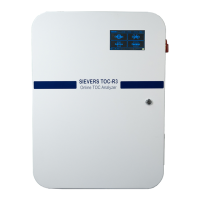SYSTEM DESCRIPTION
Chapter 2
............
Sievers TOC-R3 Operation and Maintenance Manual
DLM 95000-01 EN Rev. A 45 © Veolia 2023
physical properties of the sample and organic species present in solution. Calibration and
Method parameters may need to be adjusted depending on the application.
The "raw" PID Detector signals are displayed as “POC/VOC in ppm” and the measured
concentrations of POC/VOC are displayed in “mg/L”.
To verify your PID Detector variation, go to the Menu → General → Machine
Configuration screen and refer to Table 2-3, “Typical PID Detector Measuring Range,”
on page 45.
Sensors
The Analyzer contains the following Sensors. These Sensors provide real-time feedback
about different Analyzer system components. For more information, see “Sensors” on
page 134.
• BF1 (Carrier Gas Flow In Sensor) — Displays the current “Carrier Gas Flow In” to
the Analyzer.
• BF2 (Carrier Gas Flow Out Sensor) — Displays the current “Carrier Gas Flow
Out” of the Analyzer.
• BP1 (Pressure Reactor Sensor) — Displays the current pressure at the nozzle of
the Furnace (shown as “Reactor”) (EB1).
• BP2 (Pressure Nozzle Sensor) — Displays the current pressure at the nozzle of
the Injection Accumulator (CM1).
CM1 — Injection Accumulator
The CM1 (Injection Accumulator) is a pressure vessel that stores a large volume of
Carrier Gas used to inject sample into the Furnace. The CM1 uses the system inlet
regulated pressure (the “Carrier Gas Flow In” pressure setting). The “Carrier Gas Flow In”
setting should never exceed 35 l/h.
Table 2-3: Typical PID Detector Measuring Range
Purchased
Optional Detector
PID Detector Range
POC/VOC
a
[ppm]
(Firmware Label)
b
a. PID Gas Concentration Range.
b. “PID Range” value is found on the Menu → General → Machine Configuration
Screen.
POC/VOC
c
[mg/L]
(Analytical Range)
c. Liquid Sample Concentration Range.
Up to 25 mg/L as
POC/VOC
2000 Up to 25

